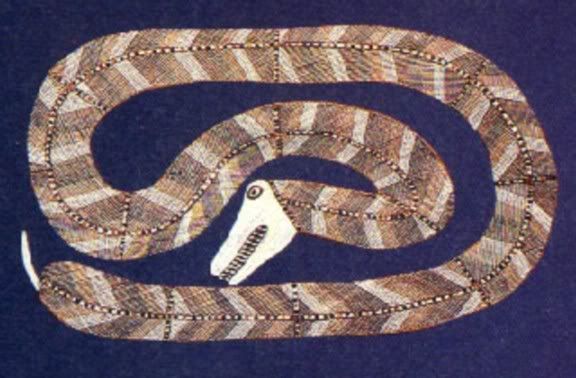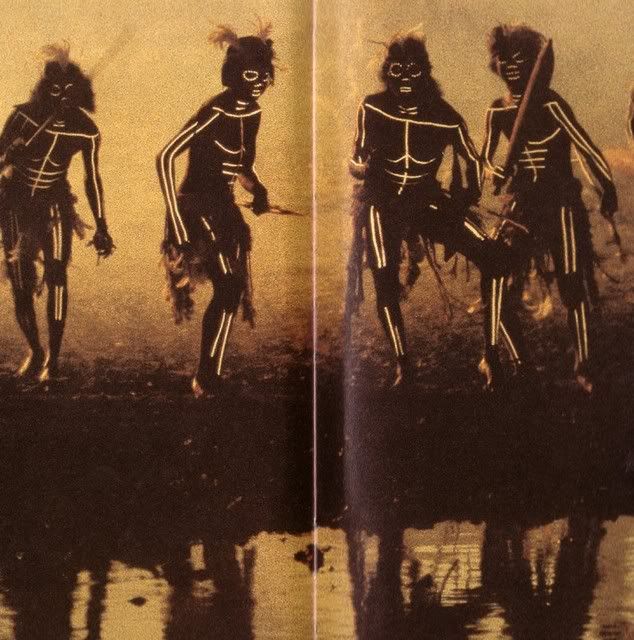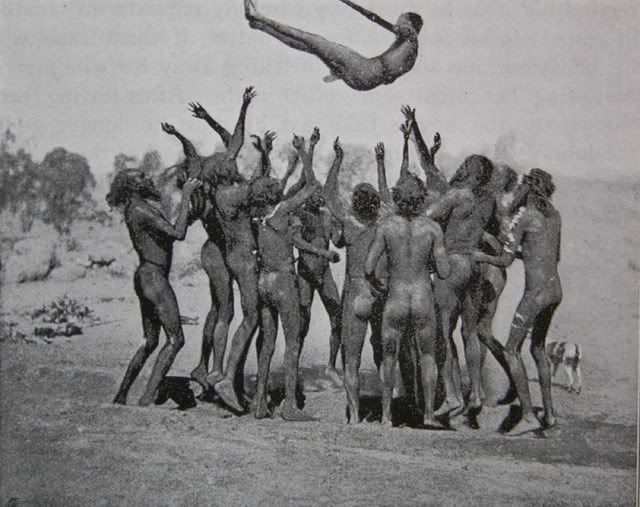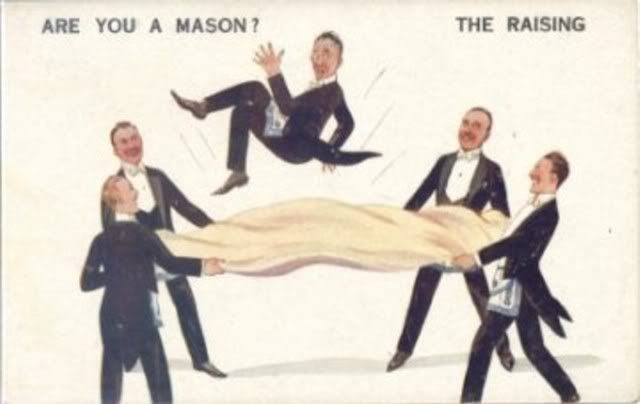|
|
Post by Tamrin on Aug 25, 2008 7:26:44 GMT 10
Noble Fiction:To the uninitiated, Aboriginal ceremonies, especially those of the higher degrees, appear to contain fantastic elements and confer supernatural powers, stretching our credulity. Jeremy Beckett, in a foreword to Elkin's Aboriginal Men of High Degree, suggested (p.xix): One possibility ... is that some of the medicine man's marvels are deceptions, not in the fraudulent sense but the religious, what W.E.H. Stanner has called the "noble fiction." Lower-degree initiations are often conducted in this way: a boy is told that the roaring noise he hears is Daramulan coming to burn him to ashes before re-forming him. But when his eyes are unveiled, he discovers the bull-roarer; now he learns a more precious truth, that Daramulan's voice is "in the wood." The fiction is a secular screen for truths too sacred to be revealed to the uninitiated. As Kenneth Maddock puts it, the novices are deceived only to be enlightened, and the outcome is not skepticism but faith. Alternatively, many anthropologists, while allowing for dramatic elements of deception, do not dismiss the possibility of some Elders understanding and being adept in their application of the hidden mysteries of nature and science. As Professor Elkin wrote (p.66): It is possible that there is some historical connection between the yoga and occult practices of India and Tibet and the practices and psychic powers of Aboriginal men of high degree. Hinduism spread to the East Indies. Yoga is a cult in Bali, and some of the remarkable feats of the Australian medicine men are paralleled by their fellow professionals in Papua. Further source:Adolphus Peter Elkin, 1994 (org. 1978), Aboriginal Men of High Degree: Initiation and Sorcery in the World's Oldest Tradition, (Second Edition), Inner Traditions, Rochester, Vermont, USA
|
|
|
|
Post by Tamrin on Aug 26, 2008 7:35:22 GMT 10
In describing Aboriginal Men of High Degree, Prof. Elkin wrote:
|
|
|
|
Post by Tamrin on Aug 26, 2008 14:35:30 GMT 10
|
|
|
|
Post by Tamrin on Aug 26, 2008 19:55:54 GMT 10
Our Guide:I turn now to some personal experiences, shared with my wife Brenda, which deepened our appreciation of the indigenous cultures and demonstrated the richness of this region's Aboriginal heritage. The first date was that of the 1997 winter solstice, which coincided with the full moon. Our guide was Paul G*****, who had travelled for ten hours from Brewarrina, near Bourke and Lake Narran, one of the State's most sacred Aboriginal sites (Havecker, p.i). We have returned several times, (once camping overnight). Our venue was the Yango State Forest, near Wollombi, north of Saint Albans. This area was one of the first settled by Europeans and had long been logged, with little of the original rainforest now standing. The first stop was at a lookout, where we were awed by a vista dominated by Mount Yengo and heard Paul's introduction to Aboriginal traditions. Paul described the well-known dreamtime stories about how various animals acquired their unique characteristics as being `just-so' stories. They are no more and no less important in Aboriginal cultures than are fairy tales or fables in European cultures. The stories usually contain basic moral lessons and are primarily told to satisfy the curiosity of children and, no doubt, whites. Paul also said that, among aboriginals, mediation is often practiced while lying on marked and specified sites or, with practice, anywhere. While usually enjoying great liberty and shown much tolerance children are strictly instructed from an early age not to disturb an elder sitting, quietly alone, lest he or she is meditating. For example, Professor Elkin reported the following instructions (p.58): When you see an old man sitting by himself over here in the camp, do not disturb him, for if you do he will "growl" at you. Do not play near him, because he is sitting down by himself with his thoughts in order "to see." He is gathering those thoughts so that he can feel and hear. Perhaps he then lies down, getting into a special posture, so that he may see when sleeping.
|
|
|
|
Post by Tamrin on Aug 26, 2008 20:16:59 GMT 10
Mount Yengo:  Uluru UluruHigh places, such as Uluru, and especially flat-topped mountains, such as it and Mount Yengo, have a special significance to Aboriginals, (as in many cultures throughout the world). At one level of meaning, they are each said to be the dreamtime site where the Supreme Being, Baiami, stepped when descending to or ascending from this earthly plane, (hence, according to the "just-so" version, the flat top). At a complementary level of meaning, they are said to be sites of great power, where spirit and matter intersect. At a further complementary level of meaning, these are the sites for what some tribes call the Intichiuma ceremony, which is the ritual making of the wise men and women of high degree (implied by Cowan, 1992 A, p.17), the sites being taboo for all other purposes.  Mount Yengo Mount Yengo
|
|
|
|
Post by Tamrin on Aug 28, 2008 7:19:31 GMT 10
Wollombi:Our next stop was at a 'map site' featuring numerous rock carvings indicating the direction to different locations such as the birthing site and sites for various rituals. It also featured a 'compass', showing the direction of some principal tribal territories, for the tribes that gathered at Wollombi, (as indicated by their animal 'totem'). Reading from a local guide (Goudie & Hickey, p.7), we found: The term "Wollombi" is aboriginal for 'the place where the waters meet', and it would appear that it was significant to the blacks not only for this, but also for the fact that the Wollombi area seemed to be the geographical dividing line between three N.S.W. tribes: the Awabakal of Lake Macquarie, the Kamilaroi of the New England region, and the Darkinung of the Hawksbury River.
More importantly still, the mountainous region just west of Wollombi [where we were] contains many important ceremonial sites which were used by all the aboriginal tribes, for tribal boundaries disappeared when it was time for religious and ceremonial events. The ceremonial path taken appears to have begun at Wollombi, and proceeded up Yango Creek into the mountains. Referring to similar gatherings, Bro. Etheridge (p.20) wrote: The arrival of each succeeding contingent of visiting associated tribes was hailed by those who may be termed the "hosts" with shouts and acclamations, accompanied by the upward-pointed gesture with bough, boomerang, or finger to the Great Master - for this is the gesture-sign by which these tribes indicate the name of the "dreaded spirit" which it is not lawful to speak before the uninitiated, or in places where it is not sanctioned by the performance of the ceremonies, which he first instituted and taught his people. The 'map site' indicated directions to sites with /|\ 'emu tracks' /|\ carved into rock. At first sight (to Western eyes), they resembled arrow heads but this interpretation would have led us in the opposite direction. Further source:M. Goudie & E. Hickey, (Editors), 1981, Wollombi Valley: Description and History, (Revised Edition), Wollombi Valley Progress Association, NSW
|
|
|
|
Post by Tamrin on Aug 28, 2008 7:30:34 GMT 10
Guardian:
The first anthropomorphic rock carving we saw represented the ever present dreamtime guardian of the site, wielding a boomerang in warning. The figure's spiritual nature was indicated by lines radiating from the head, like a nimbus or halo in Western art, and by a line drawn across the hip, suggesting the development of spiritual instinct, also known as `gut feeling'.
According to Paul, who did not know I was a Mason, this was the mark of a third degree initiate. We were shown that those of the first degree had a line across their throat and those of the second had a line across their chest signifying, at one level of meaning, that they were expected to master their fallible qualities of reason and emotion before finally mastering instinct or intuition—the one quality which cannot err (consider how advertising and propaganda can manipulate facts and emotions). Curiously, the Aboriginals share our association of reason, emotion and instinct with, respectively, the head and tongue, heart, and gut.
Passions & Prejudices:
The next figures we were shown were of a large man holding a smaller man and striking him with a boomerang. The smaller man was shown to have a spiritual nature by the above symbols and by dots over his head and body, indicating that all his physical and spiritual senses were alert, (i.e., all his `eyes' were open). His small size indicated his readiness to learn. In contrast, the size of the larger man was said to indicate he was full of preconceptions. He had no spiritual makings, his phallus was large and his head was said to resemble his phallus. This vignette proclaimed "No Dickheads". This vulgar term derives from its proper Aboriginal usage describing a person ruled by their passions, (whereas a person had to be able to keep their passions and prejudices within due bounds, before being considered fit for initiation).
Karadji Man:
Another figure showed a man of high degree, a Karadji (or a Wirinun or Dragana, as such men and women are respectively known locally). The product of the complete initiatory process, to which all may aspire but to which few are chosen. The figure was fat, indicating being full of knowledge, had wings (being emblematic of magical powers) and wore slippers, representing the shoes made from blood and emu feather and sometimes worn by high initiates, (in English, aboriginals call such a man a `feather foot').
Final Impressions:
After lunch, we moved on to view other rock carvings and cave paintings. Some had been preserved for thousands of years, while others remain 'works in progress', such as the sprayed silhouettes of hands which Aboriginals still make, as a solemn gesture, upon initiation and when visiting another tribal territory or sacred site for the first time (or after a prolonged absence).
We saw designs in caves and on wave-like overhangs, which provided natural shelters. We tried to imagine the area with its original, rain forest canopy. We felt the tranquillity, antiquity and vastness of the place. We sensed a sacred presence and reality even greater than the beautiful splendours revealed to our physical senses. The totality of that first day is difficult to communicate: You had to be there. The experience enlivened Brenda and I and overshadowed our thoughts and activities for many days and remains with us still.
|
|
|
|
Post by Tamrin on Aug 28, 2008 20:53:11 GMT 10
Dr. Nicholas Peterson is recorded, saying (Furlonger, tape 1 of 5 / part 2 of 10): The effort that people put into organising ceremonies [and] the importance of those ceremonies to people cann't be doubted. For instance, in 1972 to 73, my wife and I lived at Uundamoo ... 200 miles north-west of Alice Springs. And, for six months of the period we were there, twelve boys were secluded in the bush for the whole period; they'd been circumcised, and after that they were given religious instruction ... about four [or] five times a week by the older men, every afternoon. And many nights they'd stay up singing and learning songs for an hour, two hours, three hours, sometimes all night, over that whole six month period. And if you walked into Uundamoo, you'd see absolutely no evidence of it; you cann't hear the singing from the camp; you wouldn't notice that ... up to a hundred people were missing probably, because ... people could be scattered anywhere. And, that unless you actually went out there and saw what was happening, you'd have no evidence for it. And Aboriginal people aren't keen to advertise these ceremonies because they find that often white people behave in a very gross way when they're there. They barge round taking photographs, which they then publish, revealing what's going on. And it's not as though it's anything, if you like, untoward going on. It's ... just like the Freemasons have a hierarchy which is created by control over a body of knowledge; it's exactly the same in Aboriginal society; it's that the hierarchy of authority of the Elders rests in the fact that they know things which people younger in the hierarchy don't know and that the people at the bottom want to know. And they have to work for it and work through it. And, by publishing photographs and publishing tapes of the ceremonies and songs, and telling them what the old people know, you're immediately undermining the authority of the old people and the whole structure of the ceremonies. So I think that that's a major problem..., in a sense, for Aborigines, ... that is letting the general public really see the reality of their religious life, when it is secret. Further source:Brian Furlonger (Narrator), 1979, Kunapipi the Earth Mother: A History of Aborigines and the Land, (audio), Australian Broadcasting Commission, Sydney |
|
|
|
Post by Tamrin on Aug 28, 2008 21:05:00 GMT 10
In Alice Springs, in 1986, Pope John Paul II addressed Aboriginals: He commended their traditions, saying (p.166) they were: " .... your own way of touching the mystery of God's Spirit ...." in " .... The Great South Land of the Holy Spirit." He added (pp.168/9): " You marked the growth of your young men and women with ceremonies of discipline that taught them responsibility as they came to maturity .... You have kept your sense of brotherhood." Other church leaders have since joined in endorsing the virtues and legitimacy of Aboriginal spirituality, culminating in an ecumenical declaration in 1997. After reading some of the preceding accounts, we may feel some irony in relation to such declarations when pondering the increasing hostility of some churches to Freemasonry. From another Roman Catholic perspective, we read of: The Chant of Jimmie Blacksmith, at its most sublime level, is a Catholic Logos interpretation of racial conflict. Set in Federation era New South Wales, it articulates a vision in which the male face of the occult – Freemasonry-- and the female face – primal Aboriginal belief – are set in an amphitheater of dialectical conflict, a conflagration that can only be extinguished through the annihilation of the weaker by the stronger or by people choosing to live the challenge of the Gospel of Jesus Christ. It is written “obliquely” so that at the level of appearances, it is simply a story of racial hatred, injustice and revenge. At a deeper level, this didactic parable “obliquely” explores the metaphysical essence of fallen human nature and redemption in terms of the Catholic ontology of Theotokos – Mary the Christ-bearer. Indeed, despite being told (Stanner) White Man Got No Dreaming! perhaps our two traditions are not so much at odds as that exclamation suggests. Many people raised in western traditions have little sense of structure, direction and meaning in their lives, when compared with the rich heritage of the original Australians. Even so, as Freemasons we might suggest that the exclamation overlooks our heritage and that the "Jimmy Blacksmith" narrative misinterprets our Craft. Sadly, only a minority of people presently avail them of participation in either the rich heritage of Aboriginals or of Freemasons. Further sources:John Paul II, 1986, The Pope in Australia: Collected Homilies and Talks, St Paul Publications, Homebush, NSW William Edward Hanley Stanner, 1979, White Man Got No Dreaming, Australian University Press, Canberra  The Rainbow Serpent The Rainbow Serpent |
|
|
|
Post by Tamrin on Sept 3, 2008 1:55:25 GMT 10
To ascribe special, psychic powers to Aboriginals is discriminatory, albiet positive discrimination, but none-the-less discrimination. First and foremost they are people—people who, like all others are simply trying to get on with the mostly mundane details of everyday day, coping as best they can with their circumstances. That said, overall the linked article (below), published by the Australian Institute of Parapsychological Research, Inc., is a reasonable outline of research in this field. |
|








